I have this friend. Let's call her Rachel. She's one of the funniest people I know, in a charming, often acerbic but never cruel way.
She also happens to be a wonderful cook and bilingual - Spanish is her second language, as she spent most of her youth in Catalonia aka Catalunya, in Spain.
The fact that she's from Glasgow is just the icing on the cake, as it means that she'll slip from a Scottish brogue into perfect Spanish without a blink.
So when she decided to start her own Catalan Cooking Class, I thought "Sign me up!". As far as the online food community are concerned, Rachel is the Catalan Queen. I was honoured to be invited to attend the inaugural class ...
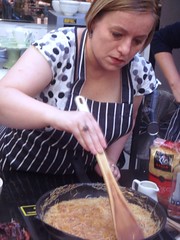
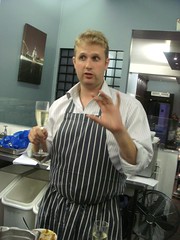
The Catalan Queen and Gareth Groves of Bibendum
It's Tuesday evening - the venue is the lovely patisserie Bea's of Bloomsbury. I take my husband along as I think he'd have fun and it's a good decision as, within minutes, Rachel has us all laughing as she tells us stories about living in Catalunya.
The six of us get aproned up and then we go to our communal worktops, where Rachel explains to us a little about the Catalan region, its people and its cuisine and that we're lucky enough to have a tutored wine-tasting as well courtesy of Gareth Groves of Bibendum Wines.
She then explains what we're about to make - starting with fideua, a dish a little like paella but with noodle-like pasta instead of rice and a wonderfully intense base called sofregit (a tomato and onion passata). We're also adding squid to give it an even richer kick.
Whilst she tells us about the dishes' origins, each of us dice ingredients for the sofregit with the biggest, sharpest ruddy knives I have ever seen. In fact, as I'd sliced the tip of my finger off the day before, I shun these machetes, beautiful as they are, and gratefully take the smaller knife that's offered to me with a smile by one of Rachel's able assistants.
The sofregit takes a while to cook, so we stick the pans on the induction hobs for it to caramelize (for want of a better word) to a rich, dark, sticky state. And although we need to keep an eye on the sofregit and give it the occasional stir, it's time for us to snack.
There's three types of cheese including a goats' cheese called Garrotxa and my favourite Manchego, roast and Parma ham, toasted broad beans, Gordal olives, and guindillas – sweet, spicy green chilli peppers.
Rachel also shows us how to make pa amb tomàquet – bread rubbed with ripe tomato, which is much more delicious than something so simple ought to be.
And just in case we're still peckish, she invites us to flash-fry some chorizo in white wine and black pudding in olive oil and then dig in. I am a firm believer that hot chorizo makes everything better.
As the sofregit simmers away, it's time to make romesco sauce and alioli to accompany the fideua.
We make two types of romesco (a kind of almond pesto) - one is authentic with nyoras, those fat burnished red dried peppers you see bunches of decorating comedy bistros, and one with less authentic but more easily available smoked paprika (never sweet).
They're both incredible - I prefer the one with paprika, my husband loves the one with nyoras.
And when I say we make the romesco, I mean every member of the class - it's not a case of Rachel cooking whilst we nod and take notes - we're getting stuck right in and (bliss) tasting all the way, as she encourages us to add a bit more of this and a bit more of that.
I think this is the reason why it works so well - I'm not keen on didactic cookery classes, much preferring to have knowledge imparted to me almost by stealth and Rachel is a pro. It feels like a night in with friends rather than a class of any kind. And yes, I am biased as Rachel is a friend of mine, but she hosts so well that I feel like I've known everyone there for years.
The friendliness takes on a slight but healthy competitive edge, as Rachel asks us to split into teams to attempt to make alioli, which is literally garlic and oil made into a wickedly powerful mayo.
I'm in charge of pestle and mortar; my husband's in charge of drip-feeding the olive oil. I grind and swoosh the garlic and oil as we race against the others to get it to emulsify and resemble something vaguely edible.
The end result is strangely grey, but we're so proud that the mixture hasn't split that I do a little dance.
Next we cook some fideua pasta in lots of fish stock and then when it's ready, we combine this with the squid sofregit which has turned into rich, saucey heaven and finish it off in the oven so it becomes a kind of noodle-cake (this is a very, very good thing).
The class ends with us sitting down together to eat our fideua with the romesco and the alioli and to drink some rosé wine. There's dessert with ice cream too – bread, red wine and spices which tastes boozily mulled and is apparently used to sedate Catalan children (I may have got this bit wrong).
I loved every minute of it and I would heartily recommend the course to anyone who wants a fun, interactive evening, as well as people who want to learn more about Spanish cuisine.
But please don't just take my word for it - Delicious Magazine reviewed the Catalan Cooking Class here.
And if you'd like to know more about the wine we tried, read Gareth Groves' review at Bibendum Times
Catalan Cooking with Rachel McCormack
£60 a head
8 people max per class
Held every other Tuesday
www.catalancooking.co.uk
Bea's of Bloomsburys
44 Theobald's Road
London WC1X 8NW
020 7242 8330
http://www.beasofbloomsbury.com/



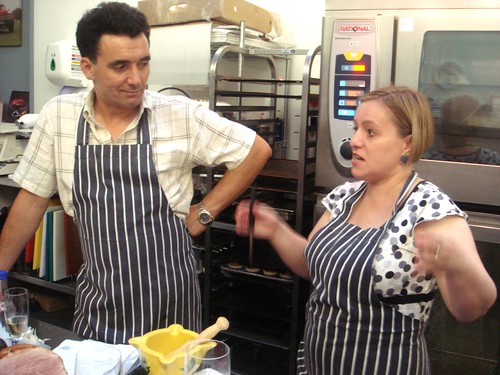
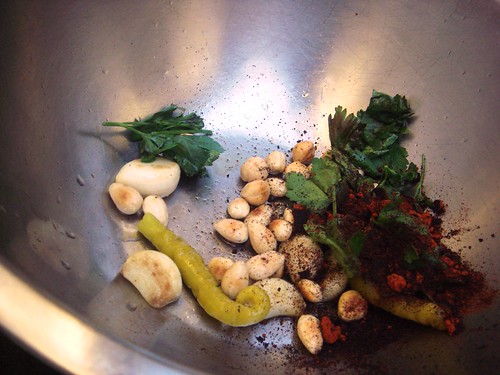
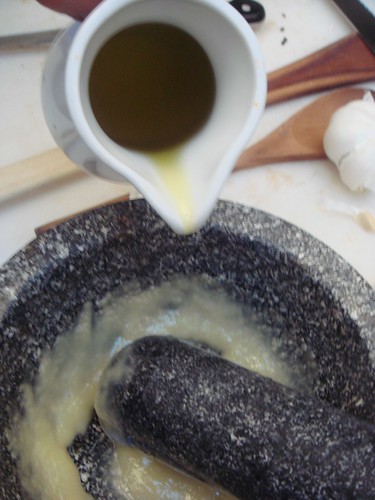

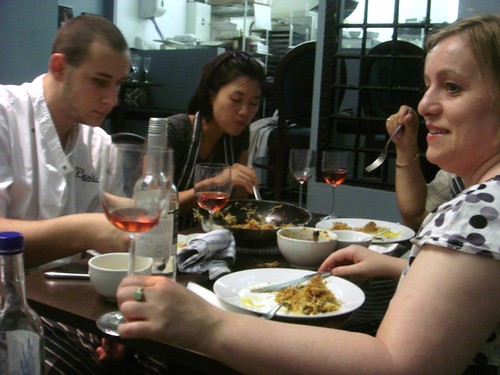
Comments
Great write up.
@Greedy Diva - Of course the wine bit was wasted on me :D
@Suzler - That was some pungent alioli - loved it though!
In fact, because of our dear friend Rachel, I am the first non-Spanish godparent of a Jamon I call Hilario.
Yes really.
@Mr Noodles - Who doesn't love noodles? :D
@Alisa - You should try a class if you can :)
@Sasa - I will call her Ursula from now on